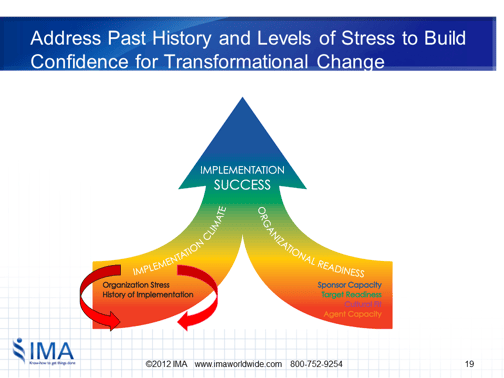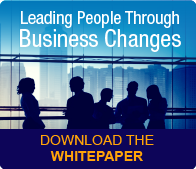Fast. Faster. Fastest! In today's crazy, busy work world, the drive to accelerate transformational change, enterprise wide changes, really any type of business change is greater than ever before. Organizations who are able to implement faster are figuratively one step ahead of their competition and ultimately more successful. 
As a Change Agent, what can you do to address this constant "need for speed” that is so often being driven from the top of the executive pyramid? When assessing the speed of a project, the AIM change management methodology looks at two major components:
- Implementation Climate and
- Organizational Readiness
By focusing on these two components in a pro-active way, you can go faster, while still achieving implementation success.
Implementation Climate
One of the critical elements for implementing at speed is knowing what the environment is like for the change you are introducing. Your change isn’t introduced into a vacuum—your success is impacted by the context of all the other changes going on in the organization at the same time, as well as the organization's past history.
Organizational Stress
Today, virtually all organizations have too many changes chasing too few resources. When you are so focused  on your own change project, you can overlook the fact that your Targets and Sponsors have many other changes that they are dealing with simultaneously. No change occurs in isolation!
on your own change project, you can overlook the fact that your Targets and Sponsors have many other changes that they are dealing with simultaneously. No change occurs in isolation!
So, when organizations commit to large-scale, complex changes like enterprise-wide transformation, leaders need to have their eyes open to what the levels of disruption will be, not just for them, but for everyone else who is impacted. And not just for this change, but for all the changes affecting the Targets.
TIP: IMA’s Organization Change Stress Test provides a context for understanding the current levels of organizational stress, and the climate in which changes will occur.
Past History
Based on our 25+ years in Change Management Consulting supporting global clients, we know there is great value in looking at past history. Every time you implement, you are teaching the organization lessons on what is important, and what isn’t. For example, failed implementations that still live on can often be a source of resistance for the current change. Awareness of how the Targets of this change perceive past implementations is critical to building credibility for the future and can help you to see where there are opportunities for acceleration.
TIP: The Implementation History Assessment measures perceptions of past patterns of implementation results, since these same patterns are likely to be repeated. The data output is used to determine new strategies for overcoming identified barriers to implementation.
Organizational Readiness for Change
Building readiness for your change is faster and cheaper than paying for it later in resistance {Tweet This}. If you can build readiness early in the project and continue while the change is going into effect, you’ll save yourself a lot of time, energy, and resources.
But as Change Management experts, we know that readiness involves much more than training and communications! Organizational readiness, as defined in the AIM change management methodology, includes the following four key elements:
Sponsor Capacity
You must have the demonstrated, visible commitment of every Sponsor cascading down the organizational levels. It is this cascade of Expressed, Modeled, and Reinforced behaviors that enables you to move at speed.
Target Readiness
You will need to identify the sources of resistance and prospectively put strategies and tactics in place to manage the resistance. Resistance is directly related to how disruptive the change is. Resistance in and of itself isn't bad, but left unmanaged, it will slow you down!
Cultural Fit
Your change is either consistent with the current culture or it flies in the face of the norms and unwritten rules. When you are introducing transformation, you know up front you are dealing with a culture change. You must have very powerful reinforcements that align with your transformation in order to get people to do "different things differently."
Agent Capacity
Your Change Agents must be carefully selected based on specific skills, traits, and personal characteristics. You will need to set up a Change Agent structure and ensure these individuals have the skills and knowledge to drive the implementation. It's critical for Change Agents to have trust and credibility with both the Sponsors and the Targets.
Of all these factors, Sponsor Capacity is the most critical. No matter how skilled your Change Agents are, they can’t make up for a lack of Express, Model, and Reinforce behaviors by Sponsors!
So, the next time you are asked to implement a change faster, evaluate it against the critical factors of climate and readiness. The AIM change management methodology systematically addresses both of these factors to help minimize business disruption while increasing the speed of implementation.
How does your change management methodology help drive speed?


